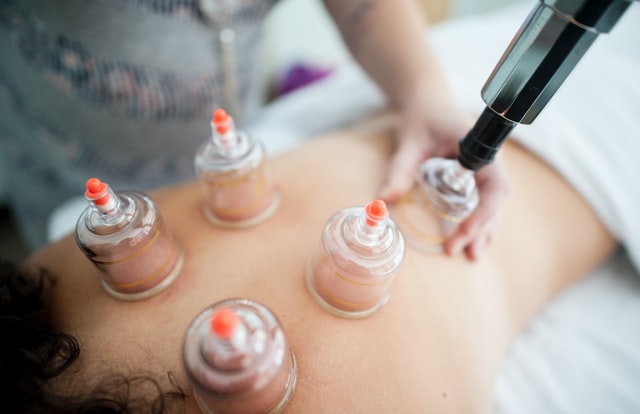What the cup??
In 2018, after taking a cupping certification course, I started using the therapy on anyone willing to try it. At first, I didn't really know that much about it but had heard of Michael Phelps' famous marks after the Rio Olympics. During the course I became intrigued to learn this technique has been around for thousands of years, and surprisingly, it feels good! However, most importantly, after trying this on so many willing participants, I have found this to be one of the best tools in my practice for effective, lasting results.
How it works
Cupping involves placing small plastic or glass jars on the skin and creating a vacuum by suctioning out the air. The underlying tissue is raised, or sucked, partway into the cup. Depending on the goals of the treatment, anywhere from just 1 or up to 20 cups may be used on the body at one time for a few minutes up to 20 minutes.
One way to think about cupping is that it is the inverse of massage. Rather than applying downward pressure into the muscles, the suction uses pressure to pull the skin, tissue and muscle upward, creating a decompression effect which I believe is part of why I have found this to be so effective.
The suction and negative pressure provided by cupping can loosen muscles, encourage blood flow, and sedate the nervous system. While studies on cupping therapy have been inconclusive in determining its effectiveness, I have found cupping in my practice to have significant, lasting effects, in some cases years of pain eliminated after one cupping session. I have used it successfully in addressing nerve compression in arms and wrists, back and neck pains, stiff muscles, migraines, and for temporary relief of chest congestion due to cough.
What it feels like
You will usually feel a tight sensation in the area of the cup. Often, the sensation is relaxing and soothing. Depending on the comfort and the therapists assessment of the problem, the cups may be moved around or left in place. On a limb, they may be left on as an 'anchor' for a muscle stretch, especially to assist athletes in reaching an optimal stretch. They may remain on your body briefly or for longer amounts of time.
Cupping causes the area of the skin below it to temporarily turn red, blue or purple, leaving painless, circular marks. The skin coloration can last anywhere from a few days to a couple of weeks. I have found that usually clients aren't even aware of the marks if in an area they don't see such as the back. Unless you don't mind the attention, this treatment should be avoided in locations on the body where clothing styles will show the marks- particularly if you have an upcoming formal event or beach vacation.
A little history
Cupping has been used for thousands of years as an ancient Chinese medicine practice and though the techniques have modernized, the original philosophy remains the same. Variations of this treatment were used by the ancient Egyptians, Early Greeks, Indigenous North Americans and other European and Asian cultures. Cupping therapy was recommended by Hippocrates, the man who many consider to be 'The Father of Modern Medicine', in his guide to clinical treatment.
If you are interested in reaping the benefits of this ancient practice in my modern clinic, simply book a massage-I include cupping in a regular massage treatment at no additional cost.
Julie
